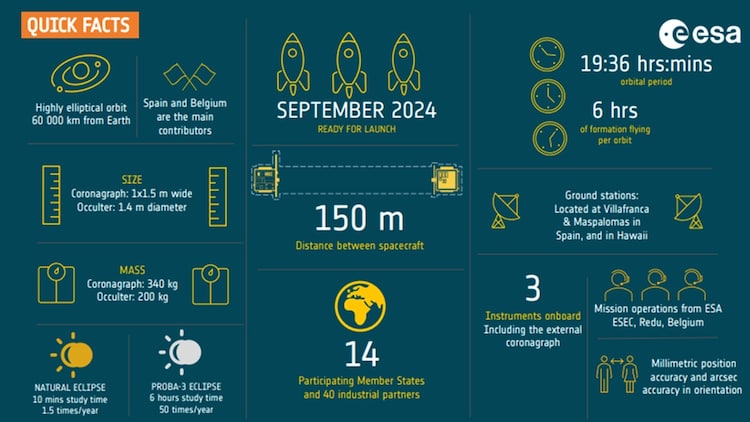
Isro will launch a European probe that will create solar eclipses on demand
The Indian Space Research Organisation (Isro) will launch Europe's Proba-3 spacecraft that would mimic the celestial phenomenon artificially in the coldness of space.

In Short
- Proba-3 will be the first to conduct a precision formation flying
- It will also form a 144-m long solar coronagraph
- It will study the Sun’s faint corona closer to the solar rim
As the Total Solar Eclipse fever slowly recedes after a spectacular show by the Sun, Moon and Earth aligning in a straight line, India is readying to push a mission that could create an eclipse on demand.
The Indian Space Research Organisation (Isro) will launch Europe's Proba-3 spacecraft that will mimic the celestial phenomenon artificially in the coldness of space.
Proba-3 will be the first to conduct a precision formation flying mission in space, where a pair of satellites will not only fly together, they will also form a 144-m long solar coronagraph to study the Sun’s faint corona closer to the solar rim than has ever before been achieved.

The sun's corona is what is visible to the naked eye during the solar eclipse. The corona is a mysterious layer of the Sun that otherwise remains invisible to the extreme brightness of the Sun and can only be seen by a coronagraph.
"The enigmatic corona – much hotter than the Sun itself – is where space weather originates. We already have instruments that can study the Sun, the low corona and the high corona, and several solar physics missions have probed the corona at various temperatures and heights. However, between the low corona and the high corona there is a region – a gap – where observations are difficult," the European Space Agency said.
The mission's success hinges on the precise positioning and coordination of the two spacecraft. To achieve this, ESA has developed a suite of cutting-edge technologies, including precision cold gas thrusters and vision-based detection systems.'
These innovations will enable the satellites to maintain their relative positions with millimetre-scale accuracy, a feat akin to a carefully choreographed cosmic dance.
The spacecraft will be launched into space on India's Polar Satellite Launch Vehicle (PSLV) from Satish Dhawan Space Centre.
While the launch date is yet to be assigned, the European Space Agency has said that it will be placed in a high Earth orbit and the two satellites, the Occulter and the Coronagraph, will fly together autonomously to perform six hours of formation flying per orbit, 150m apart.
Meanwhile, the Proba-2 spacecraft captured not one but two instances of the Total Solar Eclipse on April 8. Throughout the eclipse period, the Moon crossed Proba-2’s field of view twice, appearing as a partial solar eclipse.
The satellite was flying around 700 km above Earth’s surface in what is called a Sun-synchronous orbit, each orbit lasting around 100 minutes.
